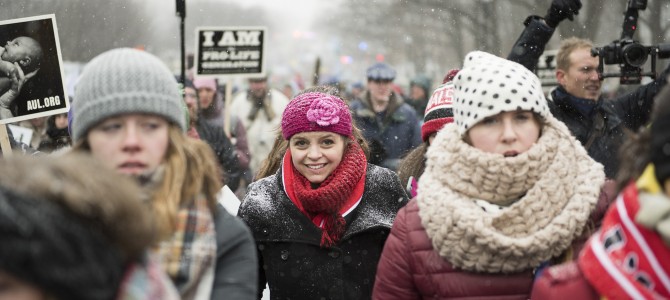Journalism 101: when a crowd of thousands gathers to demonstrate or protest, it is news. When members of the crowd come from across the country despite and eventually through a blizzard, it’s not just news, it’s a great story.
Yet, looking at the front pages of major American news websites yesterday, you’d have no idea this massive gathering was taking place.
This event, of course, is the March for Life. Thousands, if not tens or hundreds of thousands of people, gathered Friday in Washington DC to speak out against the United States’ abortion policies and to promote pro-life ideals.
But like in recent years past, there has been a noticeable absence of coverage of the march on the part of the mainstream media.
Compare March Coverage to Other Rallies
According to the Alliance for Fair Coverage of Life Issues, 200,000 people turned out for the march last year, but the big three American TV networks (CBS, ABC, and NBC) devoted only 15 seconds to covering the march. In 2014, it was 46 seconds.
Compare this to the nearly 24/7 coverage of protests and looting in Ferguson, Missouri, for weeks on end, where there were surely less than 200,000 people gathered at any one time. The mainstream media are happy to put shoplifters and looters on national television demonstrating for their cause, but won’t do the same for a peaceful group many times the size.
The media’s lack of coverage of the march is problematic in two ways. At its most fundamental level, it is an egregious violation of basic journalistic principles. Any young student of journalism knows that when a crowd gathers and plans to march, it’s a news story. When a crowd of 200,000 gathers with a historic blizzard pending, it’s definitely a story. The basic journalistic drive to “get there” and get the story is a powerful one, and not easily ignored.
Why Are People Doing This, Anyway?
That leads to the second problem. Because the march is so obviously worthy of coverage, the fact that it isn’t proves a lot of editors and reporters are trying really hard to keep it from hitting front pages.
There were some news stories about the march today, including a few from The Washington Post. With the exception of one Post story, though, the lot are quite short and focused not on the march’s goals and leadership (which should be reported, as the goals of any large march should be), but rather on the fact that it was still going to take place despite an impending blizzard.
It’s a good, newsy angle to the story, but if it’s the only angle, outlets have failed to do their basic job of reporting the news in a complete way. The story is not just that “people will still show up.” What do those people have to say? Where do they come from? What makes this year’s march different than other years’? These are all basic questions any cub reporter should know to ask.
Instead, here’s what the Post said was “in the news” Friday morning: a list of the world’s “best countries,” as determined by the U.S. News and World Report, and an update on Bill Cosby’s legal woes.
Implication: The March for Life Isn’t ‘Fit to Print’
Then there is The New York Times, the proud paper that claims on its masthead, “all the news that’s fit to print.” One of the few mentions of the March for Life on its website Friday was a parenthetical reference to Carly Fiorina’s scheduled appearance there within a story about Hillary Clinton “celebrating” the anniversary of Roe v. Wade with supporters in New Hampshire.
Another story, which is actually by the Associated Press but appears on the Times’ website, summarizes warnings and closures along the East Coast due to the coming blizzard. Here’s what it says about the march: “One major event in Washington was still on: the March for Life, an annual anti-abortion rally that’s usually one of the largest events on the National Mall. It will be held Friday, the anniversary of the Supreme Court’s Roe v. Wade decision” (emphasis mine).
If something is “one of the largest” of anything, it’s worth covering in some way every year, without fail, with the same respect that any other large gathering would get, and especially if it’s during a snowstorm. This isn’t an oversight. This is a concerted effort to ignore a message that doesn’t fit with the media’s pro-abortion agenda. Not only should March for Life participants and organizers demand fair (read: any) legitimate coverage of the event, the general public should demand that news organizations do their job, at the most basic level.
If they can’t be trusted to cover one of the largest gatherings of people in the nation’s capital, what else might they be ignoring?









